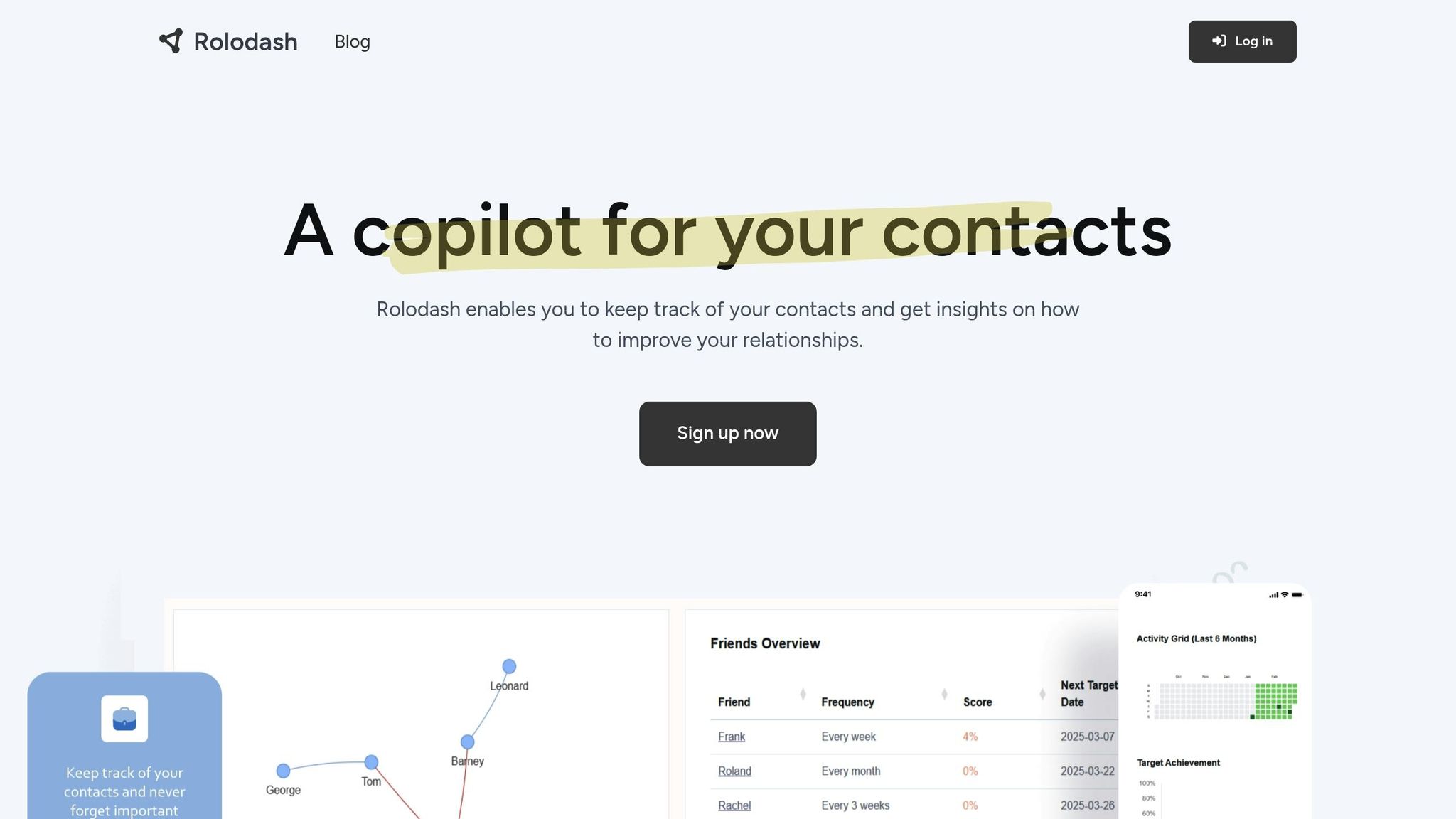Common Contact Management Problems and Solutions
Managing contacts can be overwhelming, but fixing common issues can save time and improve relationships. Here’s a quick look at the key problems and how to solve them:
Common Problems:
- Scattered Information: friends’ info spread across platforms lead to confusion.
- Duplicate Records: Conflicting data wastes time and creates inconsistencies.
- Lost Communication History: Missing past interactions means missing important information.
Solutions:
- Centralize Contacts: Use one system to store and manage all contact data.
- Clean Data with AI: Automate deduplication and updates with AI tools.
- Schedule Regular Reviews: Perform weekly, monthly, and quarterly data checks.
- Set Smart Reminders: Automate follow-ups and track key dates.
- Personalize Outreach: Use data insights to tailor communication.
By addressing these issues with modern tools like Rolodash, you can streamline contact management and create stronger relationships. Start small – centralize your data, clean it up, and stay consistent with follow-ups.
For a quick comparison of manual vs. AI-powered contact management:
| Aspect | Manual Management | AI-Powered Management |
|---|---|---|
| Data Entry | Prone to errors | Automated and accurate |
| Error Detection | Manual reviews required | Automatic inconsistency checks |
| Scalability | Limited by effort | Handles large data volumes |
| Personalization | Time-consuming | Data-driven suggestions |
Take control of your contact management today to save time, reduce errors, and build better connections.
What is Contact Management, and How Do I Use It? ⚖️♀️
4 Major Contact Management Problems
Managing contacts effectively isn’t always easy. Let’s take a closer look at five common problems that often cause issues.
Scattered Contact Information
Contacts often end up spread across various platforms – email accounts, social media and phone phone apps. This scattered approach can lead to missed details and communication gaps. Imagine storing business cards in a desk drawer, LinkedIn connections online, and phone numbers across multiple devices. It’s a recipe for confusion and missed opportunities.
Missing and Old Information
Outdated info is a silent friendship killer. Research shows that 40% of CRM data becomes outdated every year, leading to a 12% revenue loss.
Lost Communication History
Without a clear record of past interactions, it’s easy to lose context. This makes people repeat conversations or miss key follow-ups, frustrating both you and your friends. The result? Generic, impersonal chats.
Generic Communication
When data is disorganized, discussions often lack personalization. This can erode trust and hurt feelings. For example, keeping your friends’ kids’ birthdays in mind asked I that you care enough to keep on top of this information.
5 Ways to Fix Contact Management Issues
If you’re dealing with contact management headaches, try these strategies to get things back on track:
Use One Central Contact System
When contact details are spread across different platforms, mistakes and confusion are almost inevitable. Combine all your contacts into one secure, centralized system to simplify management and reduce errors.
Clean Up Data with AI Tools
AI tools can make managing contact data much easier. For example, in March 2023, Mailchimp‘s client Spotify slashed their email bounce rates from 12.3% to 2.1% in just 60 days by using the Email Verification API. This change improved email deliverability by 34% and brought in an extra $2.3 million. AI tools like these can handle tasks like data validation and standardization while automatically removing duplicates and outdated records.
Set Up Regular Contact Reviews
Keeping your contact data accurate requires regular maintenance. Do weekly scans to add new contacts, monthly cleanups to remove duplicates, and quarterly audits to archive outdated entries.
Set Up Smart Reminders
Automate your follow-ups by setting reminders based on the last time you interacted with someone, key dates like birthdays, or custom intervals depending on how important the contact is.
Use Data to Guide Outreach
Look at patterns in interactions, response rates, and communication preferences to segment your contacts. Tailored outreach based on this data can lead to significant results – some businesses report revenue increases as high as 760%.
sbb-itb-2bd8466
Rolodash: Your Contact Management Solution

Rolodash brings all your contact management needs into one place, simplifying and automating the process. Here’s a look at the standout features that make it a go-to tool.
Main Rolodash Tools
Rolodash provides tools to simplify how you manage contacts:
- Smart Interaction Tracking: Automatically logs all communications to create a complete history of your interactions.
- Network Visualization: Maps your professional network, helping you spot key relationships and new connection opportunities.
- AI-Powered Insights: Examines communication patterns to recommend the best times for follow-ups and personalized engagement.
- Secure Data Storage: Keeps your contact details safe while ensuring they’re easy to access.
With unlimited contact storage, you can manage all your relationships in one secure place without worrying about running out of space.
Getting Started with Rolodash
Start with a free trial that lets you manage up to 5 contacts. Import your contacts, tag and organize them, set up smart notifications for important dates, and track your interactions. For full access, upgrade to the Unlimited Plan for just $5/month.
Real Examples Using Rolodash
Rolodash adapts to different contact management needs. Here are some practical examples:
| Use Case | Challenge | Rolodash Solution | Result |
|---|---|---|---|
| Professional Networking | Contacts scattered across platforms | Centralized storage with interaction tracking | One reliable source for all relationships |
| Personal Connections | Forgetting key dates and follow-ups | Smart notifications and reminders | Stay on top of birthdays and milestones |
| Business Development | Irregular client communication | AI-powered insights for better engagement | More timely and meaningful outreach |
Tips for Better Contact Management
Check and Update Regularly
To keep your contact data accurate, schedule regular reviews – ideally once every quarter. During these reviews, confirm essential details like email addresses, phone numbers, and job titles. Use this opportunity to add more information to each profile for a complete view of your contacts.
Add Details to Each Contact
Build richer contact profiles by including:
- Notes from meetings or conversations
- Personal interests and preferences
- Key dates like birthdays or anniversaries
- Career achievements or milestones
- Preferred communication methods
You can also use tags to categorize contacts by shared interests, industries, or their stage in your relationship. This makes it easier to filter and organize your network when needed.
Keep Contact Data Safe
Securing contact information means taking both technical and procedural steps. Here are some ways to protect your data:
| Security Measure | Implementation | Benefit |
|---|---|---|
| Regular Backups | Set up weekly automated backups | Safeguards against data loss |
| Access Control | Use role-based permissions | Limits access to sensitive data |
| Consistent Formatting | Apply standard rules | Keeps data organized and reliable |
| Sync Protection | Pause syncs during updates | Avoids accidental data corruption |
Always back up your database before making major updates. This way, you can recover your data if anything goes wrong during the process.
AI vs. Manual Contact Management
AI tools are changing how businesses handle contact management. Here’s a quick comparison:
| Aspect | Manual Management | AI-Powered Management |
|---|---|---|
| Data Entry | Relies on manual input, often leading to errors | Automates data entry with real-time checks |
| Error Detection | Involves manual reviews that might miss issues | Flags inconsistencies automatically |
| Standardization | Formatting varies across entries | Ensures consistent formatting using machine learning |
| Scalability | Limited by human effort | Easily manages increasing data volumes |
These differences are supported by research. For instance, 74% of successful companies review AI outputs weekly, showing its importance for growth. Furthermore, 84% of executives see AI as crucial for meeting business goals, with the natural language processing market expected to hit $112.28 billion by 2030.
Key Advantages of AI in Contact Management
- Data Management: AI monitors and fixes data issues automatically.
- Smart Categorization: Uses machine learning to group contacts based on behavior.
- Predictive Insights: Analyzes past interactions to recommend the best outreach times.
- Data Enrichment: Updates contact details from verified sources without manual effort.
While AI solves many manual challenges, it also requires strict data privacy measures, regular validation, and proper team training.
Best Practices for Implementing AI
- Organize Your Data: Clean up and standardize your contact data before using AI tools.
- Schedule Audits: Review AI-generated updates weekly to ensure accuracy.
- Use a Hybrid Model: Combine AI automation with human oversight for critical relationships.
AI is reshaping contact management, making it faster and more efficient than manual methods. With connected devices projected to grow from 9.7 billion in 2020 to over 29 billion by 2030, the need for scalable, intelligent solutions will only increase. This shift explains why businesses are increasingly turning to AI for contact management.
Conclusion
Managing contacts effectively is key to building and maintaining strong relationships. Studies indicate that businesses using well-structured contact management systems often see noticeable improvements in customer retention and team productivity. The shift from manual methods to AI-driven solutions has changed the way contact management works.
Here are three core benefits of modern contact management:
- Better Data Accuracy: Centralizing contact details in one system reduces scattered information and errors. Companies that follow standardized data entry methods report up to 84% fewer duplicate records and inconsistencies.
- Stronger Relationship Management: Advanced tools allow for personalized communication by tracking interactions and setting smart reminders. This consistency helps maintain meaningful connections with key contacts.
- Increased Efficiency: Automation of routine tasks and instant access to contact details lets teams focus on building relationships instead of spending time organizing data.
These tools not only improve daily operations but also help prepare for future challenges. The next step in contact management combines automation with human oversight, making it easier to keep contact data accurate, up-to-date, and compliant with data protection rules.
Good contact management is more than just storing information – it turns data into actionable insights that strengthen relationships. By adopting these tools and practices, you can create an organized, efficient, and personalized network that supports professional growth.
The key to success lies in using the right tools, setting clear processes, and maintaining consistent data practices. With proper execution, these systems can transform how you manage and grow your professional connections.






